Rock Climbing in the Cairngorms: Spring Start & Valley Options
Rock climbing in the Cairngorms is varied and takes you to some amazing locations. Spring is a great time of year to start exploring and experiencing a different pace of climbing coming out of winter. With snow still in the high mountains, the valley and mid-mountain crags are looking very inviting in the sun. This first blog celebrates some of these lower options. There are more than highlighted here but this is a good start, especially if you’re rock climbing in the Cairngorms for the first time.
Bouldering, Farletter, Huntley’s Cave, Kingussie, and Creag Dubh
The sunnier south-facing cliffs and boulders are looking best right now and will feel great and refreshing climbing in a different mode. Spring is an exciting season and all with a different feel of pace and focus. The clocks have just changed, and evenings can now be spent planning and grabbing opportunities to go bouldering or rock climbing after work on close by venues. The planning stage is fun and there are some great guidebooks and reference books which detail all the climbing available and include its fascinating history, and important environmental and access information.
At the moment, many bigger and more remote cliffs still have snow on them or at least on approach. The mid-mountain cliffs and valley options are great until the weather improves and the snow clears for the summer.
Bouldering can be a very efficient way of maximising climbing time, especially if you have nearby access. A few places near Aviemore spring to mind and can become a good little regular circuit, great too if you can’t find a climbing partner last minute or only have a weather window of a few good hours between the rain.
Burnside Bouldering Wall
Great for everyone, this wall has a good traverse which you can lap and extend as much as you want if you can, and provides some pretty good training. It’s highly recommended that you have a bouldering matt or even a few, especially for the higher bouldering problems to the top of the wall. A nice peaceful setting nestled just outside the forest and not really seen from a distance, it’s slightly hidden until you’re right up close. Once the midge season is upon us it’s worth having a breeze as this wall is quite sheltered at the best of times.
Classics and must-do routes:
Problems 1, 2, 3 and 5 – grades 5+ to 6a
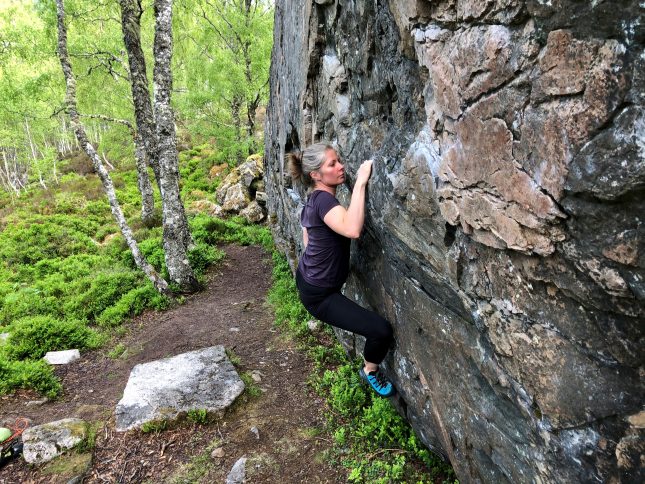
The Link Boulder:
The link boulder sits just above the road on the way to the top car park for the Cairngorm ski area. Clearly seen from the road, the boulder is quite big and sits alone. It’s granite and feels quite rough on the hands, therefore is an acquired taste and excellent for some tougher problems. The featureless nature of the granite also makes the problems feel harder than the Burnside wall but it offers great variety and quality climbing. The location too is stunning and I’ve spent many after work sessions here sitting between problems looking over the amazing view of Aviemore, the Glenmore forest, and the surrounding Cairngorm mountains.
This place is best with a team or at least a partner for climbing chat and spotting, as the landings on some of the problems are sloping and feel a little high too. More bouldering matts the better too, and I usually take at least two here. You can find details of the problems here and Burnside Wall online by searching ‘Aviemore bouldering’.
Classics and must-do routes:
Loch Morlich Arete – 5+ (the warm up!!)
Right Lip – 6c
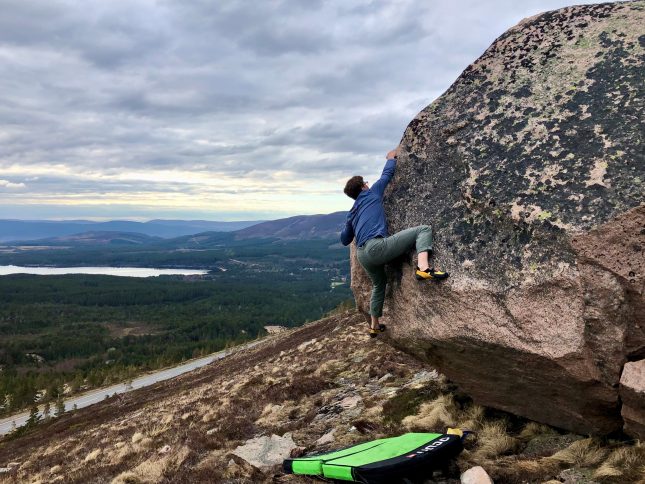
Farletter Crag
Mainly used for sport climbs now, Farletter is a popular crag (though with a few trad routes). There are many routes ranging between 6a to 7b that are well bolted, and is perfect for a quick hit or good for training. The crag is reasonably steep so survives most passing rain and therefore dries out quite quickly too. Located in a clearing in a wood, it can be a little midge-ey come the season and is also known for its mosquitoes, but nothing a little breeze, some Smidge spray and covering up can’t solve. That said it’s a great venue and always worth a look, as the climbing is good quality and provides the area with a very accessible and fun climbing option.
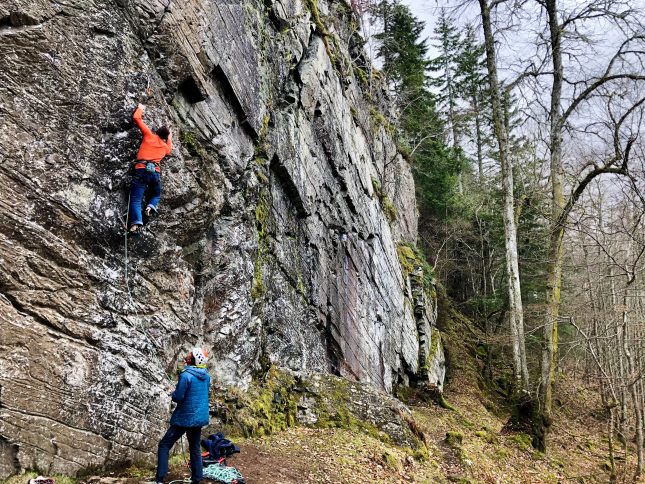
Located near Feshie Bridge and easily accessible from North (Aviemore) and the South (A9), the crag is more or less roadside with an easy 2-minute walk through the trees. The rock type is schist which makes for good edges and flat break type holds. And the base of the crag is quite flat so is great for hanging out between routes. A fun climbing venue and great for a good quality session, plus it’s always worth a visit along to the Kincraig Old Post Office café too!
Classics and must-do routes:
Most of the Farletter sport routes are well travelled – grades 6a to 7a+/7b
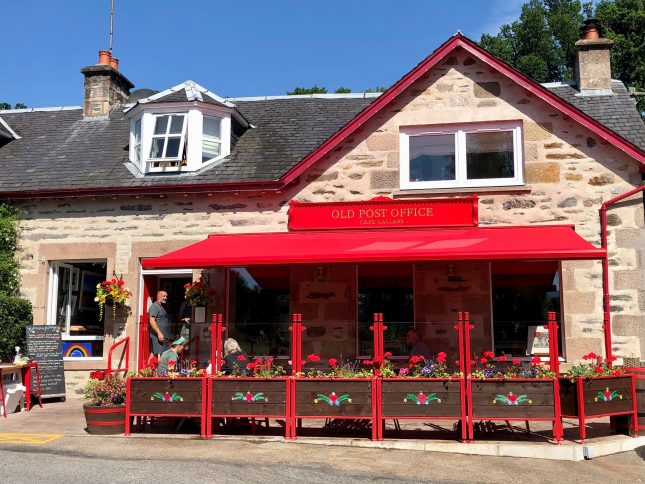
Huntley’s Cave
This crag is quite different from other valley crags. It’s generally very steep with some routes going through overlaps/overhangs and sometimes weaving through some steep terrain. One route is even called ‘double overhang’! It’s approach from the car is a short walk downhill, to a very sheltered spot located in a small river valley. You arrive at the top of the crag and take a short walk down to its base, where you can immediately see the steep nature of the crag and the horizontal banding of the rock too.
There is a full range of grades and good climbing from V. Diff to E4 all of which are trad climbs and single pitch. It’s a really nice and peaceful setting by the river and rolling field, and provides a very accessible venue for maximum climbing allowing you to climb a few routes in a short space of time.
Classic must-do routes:
Cave route HS 4b ***
Cave direct VS 4c ***
Diagonal VS 4c ***
Double Overhang HVS 5s ***
Right Hand Groove V-Diff *
Pete’s Wall E2 5c **
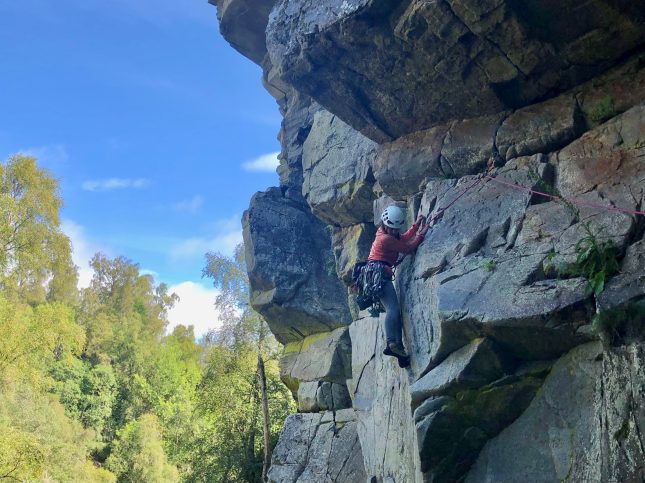
Kingussie Crag
Located above Kingussie village is a popular crag with many trad routes easily accessible and good rock. the rock is schist and most routes have good gear, if a little too popular as some of the routes have become quite polished in places. However it’s justifiably popular, with some good quality single pitch routes at a good range of grades too. Local groups often use the crag but there is normally lots of room and plenty of routes to choose from.
There is a main section of crag and a slab sitting to the side of the crag too. Allow 20 to 30 mins walking for the access above the caravan park on the hill side. The crag sits above the tree line, with views over Strathspey and the ruined Ruthven military barracks. The top and base of the crag are quite flat, making it a great place to relax and picnic between routes. The slab a short walk north from the crag is worth a look, especially with a well protected crack/groove running up its right-hand side.
Classics and must-do routes:
Left Hand Crack E1 *
Right Hand Crack HVS 5a **
The Groove HS 4b **
The Edge V.Diff *
The Slab Diff (quite bold) **
Classic Crack Diff **
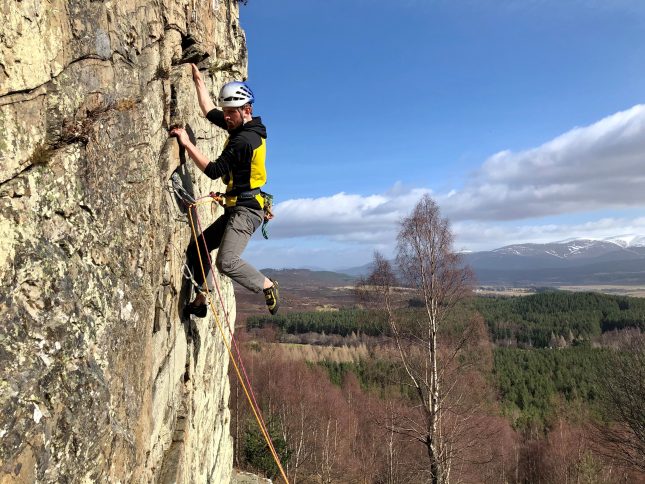
Creag Dubh
This south facing crag is famous in the climbing community. It has many classic hard routes and celebrated well in many guidebooks and reference books such as hard rock and extreme rock. Seen clearly above the road its access is good and there are many quality routes to choose from. Most of the climbing starts at VS and due to the compact nature of the rock the crag has a bold and steep reputation with limited options for gear on some routes. This reputation also makes this a special place and home to many must do classic routes in Scotland.
Most routes are mutli-pitch or at least a long pitch to an abseil descent, and are well described in guidebooks. The great wall is the biggest section, home to some of the hardest routes in Scotland and most are very bold. There are however some good fun, steep classics too on the Great Wall and on either side. I’d recommend a few visits to the crag to get into the style of climbing required here. After a few successful routes you will become hooked on the sometimes exposed and bold style of climbing. The rock on most parts is really good and gives some proper ‘out there’ climbing experiences.
Classics and must-do routes:
King Bee VS ***
Brute VS **
Inbred HVS ****
The Hill Direct E2 5b ****
Phellatio HVS 5a ***
Man on Fire E1 5b **
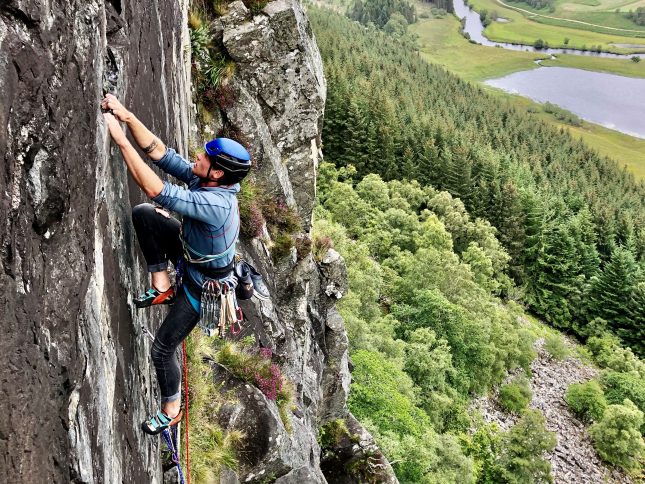
Hopefully this has given you some insight into the lower options and quick hits for the start of the rock climbing season in early spring time. In the next blog, we’ll explore the higher, more remote cliffs for rock climbing in the Cairngorms once spring is established and has brought the warmer, drier weather and you’re ready for bigger venues and adventures.
Feeling inspired to try rock climbing in the Cairngorms? Check out Glenmore Lodge’s rock climbing courses
About Stuart
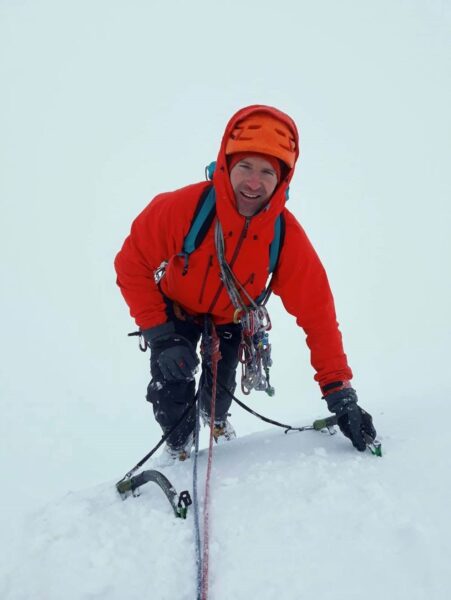
Originally from Northern Cumbria I started out hill walking in the Lake District when I was at school. I soon become interested in rock climbing and mountaineering, and was lucky enough to work and climb with Mountain Guides during my first job leaving school. Since then I’ve been working full time in the mountains for around 20 years.
At the same time as working, I enjoy climbing in my free time and have been lucky enough to go on many expeditions around the world, climbing new mountains, first ascents and tough remote summits. Places such as Patagonia, Alaska, Himalaya, Peru, Baffin Island, Yosemite and China. In 2004 I was nominated for the prestigious Piolet d’Or in Grenoble, France, for a 1st ascent of the ‘Supa Dupa Couloir’ in Alaska.
I love my job as a Mountain Guide, teaching and exploring big mountains in all weather all year round. I joined the Glenmore Lodge team in 2019 and head up the Summer Alpine programme.